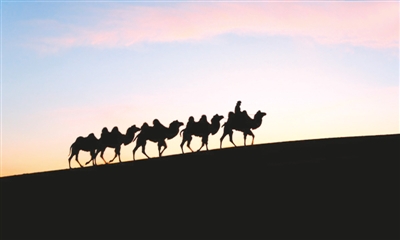
(Photo: Xinhua)
From East to West the Silk Road is rising up once more. It traverses countries between China and the Mediterranean. These lands have always been of pivotal importance in global history in one way or another linking East and West, serving as a melting pot where ideas, customs and languages have jostled with each other from antiquity to modern day.
There are obvious reasons why this is happening. Most important are the natural resources of the regions along the routes: of the Gulf countries, ex-Soviet Union countries, etc.
The combined proven crude reserves under the Caspian Sea alone are nearly twice those of the entire Unites States.
Then there is the Donbas Basin that straddles Ukraine's eastern frontier with Russia, long famed for coal deposits estimated to have extractable reserves of around 10 billion tons. This, too, is an area of rising significance because of further mineral wealth. Recent geology-based assessments by the US Geological Service have suggested the presence of 1.4 billion barrels of oil and 2.4 billion cubic feet of natural gas, as well as a considerable estimated volume of liquid natural gas.
Alongside this sit the natural gas supplies of Turkmenistan. With no less than 700 trillion cubic feet of natural gas estimated to be below ground, the country controls the fourth largest supply in the world. And then there are the mines of Uzbekistan and Kyrgyzstan. There is beryllium, dysprosium and other rare earths in Kazakhstan that are vital for the manufacturing of mobile phones, laptops and rechargeable batteries, as well as uranium and plutonium that are essential for nuclear energy and nuclear warheads.
Even the earth itself is rich and valuable. The dark earth of Ukraine, the world's seventh largest wheat producer, is so fertile that close to $1 billion's worth is dug up and sold annually.
New connections are springing up across the spine of Asia, linking this key region to the north, south, east and west, and taking many different routes, shapes and forms, just as they have done for millennia.
Transport links as well as pipelines have expanded dramatically in the last three decades. Trains half-a-mile long, link China with Germany - carrying millions of laptops, shoes, clothes etc., in one direction, and electronics, car parts and medical equipment in the other - on an overland journey that takes 16 days and is considerably faster than the sea route.
Railway lines are developing that will pass through Iran, Turkey, the Balkans and Siberia to Moscow, Berlin and Paris and new routes are being constructed that will link Beijing with Pakistan, and Kazakhstan with India.
Numerous new flights take businessmen and tourists from China to Kazakhstan, Azerbaijan, Turkey, Russia, Iran, the Persian Gulf, India and Europe.
There are the oil and gas pipelines that bring energy to consumers willing and able to pay for them in Europe, India, China and beyond. Existing and newly proposed pipelines connect Europe to the oil and gas reserves in the center of the world as well, raising the political economic and strategic importance, not only of the export's status, but also of those territories through which the pipelines cross.
Cities are blossoming, with new airports, tourism resorts, luxury hotels and landmark buildings springing up in countries that find themselves with enormous sums of cash at their disposal to indulge in their fantasies. Major new urban centers have been founded, like the capital city of Astana in Kazakhstan, which has risen from the dust in less than 20 years.
New intellectual centers of excellence are also emerging. Universities, Confucius Institutes and non-profit organizations that promote Chinese language and culture have been established in every country from China to the Mediterranean. New centers for the arts are emerging like the museums in Qatar, Abu Dhabi, and Baku, and the library in Tashkent.
Establishing how useful and important old countries were in the past can be very helpful for the future and is one reason why China is investing so heavily in bonding itself to the Silk Road that lies to the West, to reaffirm a common heritage of commercial and intellectual exchange.
As the heart of the world takes shape, institutions and organizations that formalise relations across this pivotal region are also coming into being. Originally set up to facilitate political, economic, and military collaboration between Russia, Kazakhstan, Kyrgyzstan, Tajikistan, Uzbekistan and China, the Shanghai Cooperation Organization (SCO) is becoming increasingly influential and gradually turning into a viable alternative of the European Union. Turkey has applied to join the SCO as a full member and to reorient itself away from Europe. The Asian Infrastructure Investment Bank plays an important role in infrastructure development.
History is re-examined and revaluated for its own sake. The new Silk Road is a "Silk Road Economic Belt". The world is changing around us. As we move into an era where the political, military and economic dominance of the West is coming under pressure, the sense of uncertainty is unsettling. While we ponder where the next threat might come from, how best to deal with religious extremism or how to negotiate with states who seem willing to disregard international law, networks and connections are quietly being knitted together across the spine of Asia; or rather, they are being restored.
The worldwide economic centre is shifting to the countries between China and the Mediterranean. The Silk Road is rising again。


